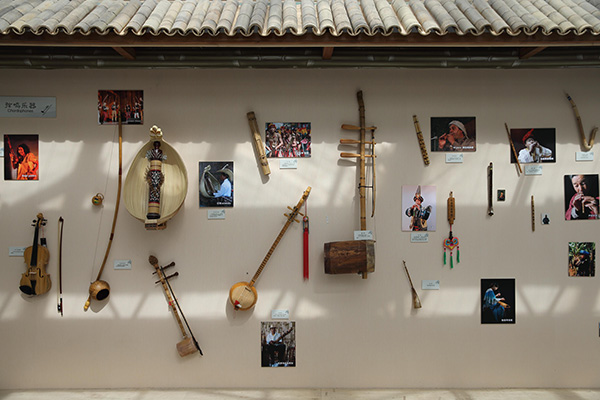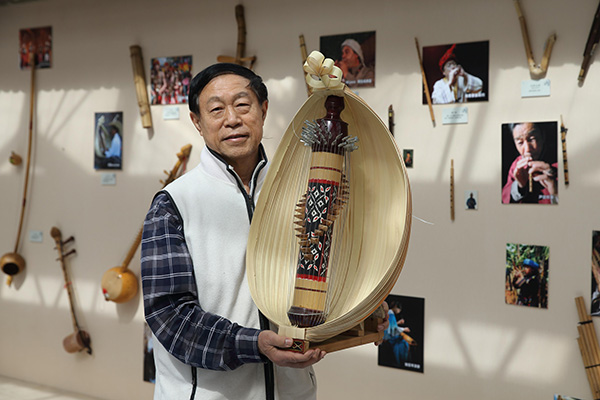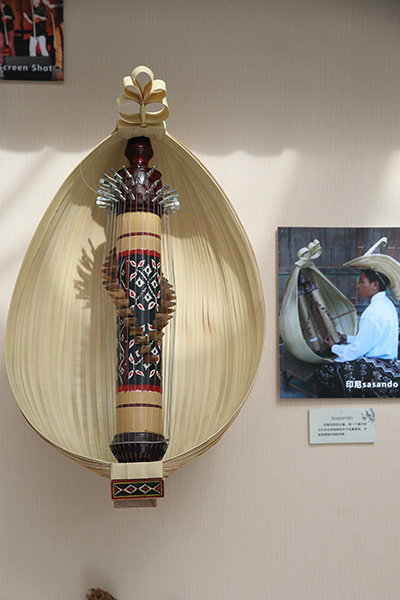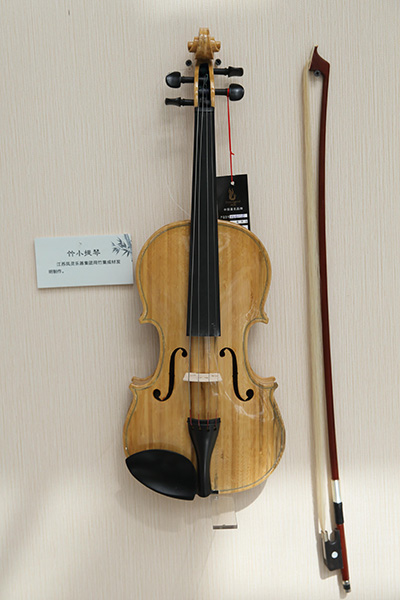
More than 100 bamboo musical instruments are on display in an exhibition curated by Wang Wei in Beijing.[Photo by Wang Jing/China Daily]??
Musician to showcase his unique crusade at Beijing concert
In 1991, Beijing-based musician Wang Wei went on a tour with China Oriental Performing Arts Group as bassist. During the tour, he became fascinated by the shakuhachi, a kind of Japanese bamboo flute. Later, he found out that the shakuhachi, which was called chi ba in Chinese, was introduced to Japan during the Tang Dynasty (618-907).
Astonished and ashamed of how he was ignorant of the country's rich musical tradition as a professional musician, Wang started learning and researching about Chinese musical instrument made of bamboo.
He has found that among the 90 wind instruments identified by the Chinese Music Dictionary, 47 are made of bamboo. The earliest bamboo instruments so far found in China were some flutes discovered in 1978 alongside bronze chimes from a tomb of the Warring States Period (475-221 BC) in Suixian county of Central China's Hubei province.
During the past three decades, the versatile musician traveled around the country to find the finest materials for making bamboo instruments. The small balcony at his home in Beijing has become his studio for making the instruments.

Wang Wei, a former bassist with Beijing-based China Oriental Performing Arts Group, started learning and researching about Chinese musical instrument made of bamboo in early 1990s. He has launched the country's first bamboo orchestra, which is going to give a show in Beijing on April 22.[Photo by Wang Jing/China Daily]?
In 1999, Wang got a patent for his bamboo marimba from the State Intellectual Property Office and so far five of his bamboo instruments have been patented from the office.
He also gathered a group of musicians to form the country's first bamboo orchestra. The orchestra now has more than 20 members and most of them have at least a master's degree in music. Together they've released five CDs.
On April 22, the 70-year-old will lead the orchestra to give a show at the Cultural Palace of Nationalities in Beijing, interpreting both Western classics, such as pizzicato polka by Johann Strauss II, and original Chinese works.
Audiences will see bamboo instruments of various sizes, shapes and designs from the longest 3.3-meter tube to the smallest 4.6-centimeter flute mouthpiece, which can produce wider sound ranges than piano key frequency.
"Though the orchestra was officially registered in 2007, we had prepared for it for decades. I want to set up a pure bamboo orchestra. All the instruments are made of bamboo, and the music we play is not modified by electronic music, so as to present the rich culture of Chinese bamboo instruments and Chinese music," says Wang.

Besides live performances, he is also the curator of an ongoing exhibition, where more than 100 bamboo instruments are on display in Beijing. In 2014, Wang has held a similar bamboo instruments exhibition at the National Centre for the Performing Arts in Beijing.
"Comparing with Western classical music, Chinese audience pay less attention to traditional Chinese instruments. But once you take the ancient instruments seriously, and look at them carefully, you will be fascinated and start to appreciate their beauty," Wang says.
He also notes that the country boasts more than 500 kinds of bamboo and the hollow, treelike grass that exist in southern parts of the country.
Bamboo is a main material for Chinese ethnic groups from the south, such as Yunnan, Guizhou and Hainan provinces, to make instruments. Wang has collected a variety of those instruments and visited those ethnic musicians, some of whom are inheritors of instruments listed on the National Intangible Cultural Heritage.
"Those instruments are rarely seen by the urban audiences. To popularize these instruments, we tried to adapt some world-famous pieces," says Wang.

One of Wang's supporters and helpers is established Chinese composer and percussionists Chen Wei, who is a member of the China Oriental Performing Arts Group.
As Chen recalls, he was overwhelmed by seeing a handmade marimba-like instrument at Wang's home in 1995. The unique sound of the instrument attracted Chen and since then, he has written and adapted more than 30 melodies for bamboo instruments.
"We try to pick the most suitable elements for bamboo instruments, whose sound is mild and bright," says Chen, whose compositional pieces, such as Bamboo Sound in Beijing and Mountain Song, will be staged during the upcoming concert.
"Bamboo music is still a new genre, which allows us large space to grow," Chen says.
Shang Lei, who learned percussion since 4 years old with the famous percussionist Liu Guangsi, a professor of Central Conservatory of Music, joined Wang's orchestra as a college student in 1999.
"I was impressed by his instruments, which occupied his home," recalls Shang of her first visit to Wang's home. "One of the biggest challenges of making those bamboo instruments is to solve the problem of cracking since the environment is quite different from the south and north."
Shang also adds that since bamboo instruments are not as popular as other traditional Chinese instruments, few composers write for bamboo instruments, which hinder the popularity of those instruments.
While fulfilling his vision, Wang is also proud that the orchestra's birth and development are also an effort of protecting the environment.
Traditionally, instrument makers have relied on hardwoods such as mahogany, cedar and rosewood to produce instruments. But those slow-growing trees can take half a century or more to reach maturity. The large consumption have caused some species to disappear.
Since bamboo is among the fastest growing plants on earth, gaining 1.2 meters every day under appropriate conditions, the State Forestry Administration has been trying to replace the use of wood with bamboo to protect the environment.
